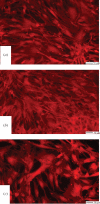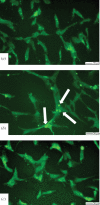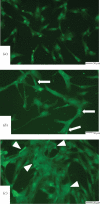Substrate-induced phenotypic switches of human smooth muscle cells: an in vitro study of in-stent restenosis activation pathways
- PMID: 21106574
- PMCID: PMC3061099
- DOI: 10.1098/rsif.2010.0532
Substrate-induced phenotypic switches of human smooth muscle cells: an in vitro study of in-stent restenosis activation pathways
Abstract
In-stent restenosis is a clinical complication following coronary angioplasty caused by the implantation of the metal device in the atherosclerotic vessel. Histological examination has shown a clear contribution of both inflammatory and smooth muscle cells (SMCs) to the deposition of an excess of neointimal tissue. However, the sequence of events leading to clinically relevant restenosis is unknown. This paper aims to study the phenotype of SMCs when adhering on substrates and exposed to biochemical stimuli typical of the early phases of stent implantation. In particular, human SMC phenotype was studied when adhering on extracellular matrix-like material (collagen-rich gel), thrombus-like material (fibrin gel) and stent material (stainless steel) in the presence or absence of a platelet-derived growth factor (PDGF) stimulus. Cells on the collagen and fibrin-rich substrates maintained their contractile phenotype. By contrast, cells on stainless steel acquired a secretory phenotype with a proliferation rate 50 per cent higher than cells on the natural substrates. Cells on stainless steel also showed an increase in PDGF-BB receptor expression, thus explaining the increase in proliferation observed when cells were subject to PDGF-BB stimuli. The stainless steel substrate also promoted a different pattern of β1-integrin localization and an altered expression of hyaluronan (HA) synthase isoforms where the synthesis of high-molecular-weight HA seemed to be favoured. These findings highlighted the induction of a phenotypic pattern in SMC by the stainless steel substrate whereby the formation of a HA-rich neointimal tissue is enhanced.
Figures





Similar articles
-
Substrate-induced phenotypical change of monocytes/macrophages into myofibroblast-like cells: a new insight into the mechanism of in-stent restenosis.J Biomed Mater Res A. 2009 Aug;90(2):465-71. doi: 10.1002/jbm.a.32100. J Biomed Mater Res A. 2009. PMID: 18546184
-
Upregulation of intermediate-conductance Ca2+-activated K+ channel (IKCa1) mediates phenotypic modulation of coronary smooth muscle.Am J Physiol Heart Circ Physiol. 2006 Nov;291(5):H2493-503. doi: 10.1152/ajpheart.01254.2005. Epub 2006 Jun 23. Am J Physiol Heart Circ Physiol. 2006. PMID: 16798818
-
Targeting connexin 43 prevents platelet-derived growth factor-BB-induced phenotypic change in porcine coronary artery smooth muscle cells.Circ Res. 2008 Mar 28;102(6):653-60. doi: 10.1161/CIRCRESAHA.107.170472. Epub 2008 Jan 31. Circ Res. 2008. PMID: 18239136
-
Type I collagen synergistically enhances PDGF-induced smooth muscle cell proliferation through pp60src-dependent crosstalk between the alpha2beta1 integrin and PDGFbeta receptor.Biochem Biophys Res Commun. 2004 Dec 3;325(1):328-37. doi: 10.1016/j.bbrc.2004.10.031. Biochem Biophys Res Commun. 2004. PMID: 15522237
-
Platelet-derived growth factor. Distinct signal transduction pathways associated with migration versus proliferation.Ann N Y Acad Sci. 1995 Sep 7;766:416-30. doi: 10.1111/j.1749-6632.1995.tb26691.x. Ann N Y Acad Sci. 1995. PMID: 7486687 Review.
Cited by
-
Higher plasma level of STIM1, OPG are correlated with stent restenosis after PCI.Int J Clin Exp Med. 2015 Nov 15;8(11):21089-97. eCollection 2015. Int J Clin Exp Med. 2015. PMID: 26885040 Free PMC article.
-
Smooth muscle-like cells resident in the media participate in spasm-induced coronary intimal hyperplasia.Exp Clin Cardiol. 2013 Winter;18(1):e65-70. Exp Clin Cardiol. 2013. PMID: 24294055 Free PMC article.
-
Long Non-Coding RNAs Might Regulate Phenotypic Switch of Vascular Smooth Muscle Cells Acting as ceRNA: Implications for In-Stent Restenosis.Int J Mol Sci. 2022 Mar 12;23(6):3074. doi: 10.3390/ijms23063074. Int J Mol Sci. 2022. PMID: 35328496 Free PMC article.
-
Serum Endocan Levels Predict Drug-Eluting Stent Restenosis in Patients with Stable Angina Pectoris.Acta Cardiol Sin. 2020 Mar;36(2):111-117. doi: 10.6515/ACS.202003_36(2).20190731A. Acta Cardiol Sin. 2020. PMID: 32201461 Free PMC article.
-
Correlation between high perfusion syndrome and stent restenosis after stent implantation.Exp Ther Med. 2016 Dec;12(6):3675-3679. doi: 10.3892/etm.2016.3813. Epub 2016 Oct 18. Exp Ther Med. 2016. PMID: 28101162 Free PMC article.
References
-
- Santin M., Colombo P., Bruschi G. 2005. Interfacial biology of in-stent restonosis. Exp. Rev. Med. Dev. 2, 429–44310.1586/17434440.2.4.429 (doi:10.1586/17434440.2.4.429) - DOI - DOI - PubMed
-
- Farb A., Sangiorgi G., Carter A. J., Walley V. M., Edwards W. D., Schwartz R. S., Virmani R. 1999. Pathology of acute and chronic coronary stenting in humans. Circulation 99, 44–52 - PubMed
-
- McFadden E., et al. 2004. Late thrombosis in drug-eluting coronary stents after discontinuation of antiplatelet therapy. Lancet 364, 1519–152110.1016/S0140-6736(04)17275-9 (doi:10.1016/S0140-6736(04)17275-9) - DOI - DOI - PubMed
-
- Burke A. P., Kolodgie F. D., Zieske A., Fowler D. R., Weber D. K., Varghese P. J., Farb A., Virmani R. 2004. Morphologic findings of coronary atherosclerotic plaques in diabetics: a post-mortem study. Arterioscler. Thromb. Vasc. Biol. 24, 1266–127110.1161/01.ATV.0000131783.74034.97 (doi:10.1161/01.ATV.0000131783.74034.97) - DOI - DOI - PubMed
-
- Farb A., Weber D. K., Kolodgie F. D., Burke A. P., Virmani R. 2002. Morphological predictors of restenosis after coronary stenting in humans. Circulation 105, 2974–298010.1161/01.CIR.0000019071.72887.BD (doi:10.1161/01.CIR.0000019071.72887.BD) - DOI - DOI - PubMed
MeSH terms
Substances
LinkOut - more resources
Full Text Sources

